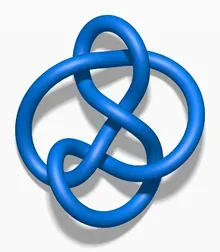To Be or Knot to Be
Hi everyone! As I mentioned in the last article about primes, this series is a place to learn about various STEM topics that I find

What are knots?
When you think of knots, you might think of your double-knotted shoelaces or your hopelessly tangled earbuds. I personally think of garlic knots. However, these sorts of knots are different from mathematical knots. What kind of snob wouldn’t consider garlic knots valid knots? Well, the difference is that “knots” like shoelaces have loose ends, meaning we can always untie them. Nothing is locked in. For example, let’s take your “knotted” shoelaces. It is two strings tied together in a way that we can technically untie (though it may seem impossible) and retie another way.

For mathematical knots, the ends are joined together to create a continuous strand.
Let’s look at a more concrete example. Take a hair tie, or a stray rubber band lying around. In their untangled form, these are circles. It might surprise you that these are indeed considered knots! This is known as the unknot, or the trivial knot. It is simply a circle with no crossings. (This is a word that will come up later). Before we get into more complex knots, let’s discuss the recent beginning of knot theory.
Start of Knot Theory
Knots first became a subject of interest in the 1860s. At this time, scientists were trying to understand matter, and a man named William “Lord Kelvin” Thomson developed a theory claiming that atoms were made up of knots. He proposed that every element was a different kind of knot. While trying to sort this out, inevitable questions arose: What sorts of properties do knots have? What makes two knots different? How can we prove they are fundamentally distinct? Let’s try to answer some of these questions!
What sorts of properties can knots have?
We’ll think about knots in terms of simple knot diagrams. First, recall our nice simple knot from before: the unknot. Its diagram is pretty straightforward:
Let’s talk about a related type of knot. Take a simple hair tie. Suppose you’re fiddling with it because you’re bored in your Zoom meeting, and you’re just twisting and turning it and end up with a tough knot. Can you return it to its original circle form? Well, yes! It might take some effort, but you can theoretically just undo each of your actions and return it to a circle. But while it’s all tangled up, it may not appear to be the unknot — it’s disguised! Knots that can deform (through some set of moves) into the unknot are called culprit knots. (Yes, mathematicians do have a sense of humor!)
Here is an example of a (truly deceitful) culprit knot.
Now, let’s take it up a (k)notch. The next standard knot is called the trefoil knot, and its knot notation is: 3_1. What is this nonsense? Let’s unpack it. First, here is a picture of the standard, simplest form of the trefoil knot:
Can you guess what the three stands for? Try to think about it from the perspective of a mathematician for a second, and see if you can find a nice reason… If you guessed that the 3 represents the number of intersections, or crossings, the knot has with itself, you would be right! Now, look carefully at the knot and guess what the 1 stands for… Okay sorry, that was a trick question. The subscripts are just an index to keep track of all the different knots that have the same number of crossings. Interestingly enough, the trefoil is the only knot with three crossings (up to deformation). For the standard knot notation of a knot, the number is something called the crossing number, which is the minimum possible number of crossings in the knot diagram (meaning there is no way to unknot it or deform it into something with fewer crossings), and the subscript is just a label counting how many we have of that type.
Here are the first several standard knots. In the diagram, 3_1 is our trefoil knot and 4_1 is known as the “figure 8” knot.
What makes knots the same?
Now you might ask, how can we be sure that some of these knots are not secretly the same? Maybe we just didn’t untangle them the right way. Could these all be devious culprits? Well, we say that two knots are the same if one can be deformed into the other without letting it pass through itself. This process of deforming a knot without it passing through itself is called ambient isotopy. So, the next time someone calls you out for tangling and detangling your hair-tie (if this ever happens), tell them you’re practicing ambient isotopy!
Okay, so now we know how to tell if knots are the same — you just have to see if you can deform one into another. So do we just have to keep trying to untangle until we get lucky? Is there some sort of method? Why, what a great question! There is indeed!
Reidemeister Moves
In the 1930s, Kurt Reidemeister proved that all deformations could be reduced to three moves: a twist (I), a poke (II), and a slide (III). This is a fantastic result because it means that we have a finite number of moves we can make, which really simplifies things. So, we can now say that two knots that are equivalent can be related by a sequence of these three moves. In other words, if you can transform a knot into another knot via these moves, they are equivalent (up to ambient isotopy). Remember our example culprit knot from before? This is the process using Reidemeister moves showing that it can be deformed into the unknot. See if you can figure out which of the three moves is being used at each step!
This is an amazing tool to prove that two knots are the same. But, can we use it to show that two knots are different? Say we are trying to deform a trefoil knot into an unknot with these moves. As we try and twist and turn it, you probably can convince yourself that it’s not possible, but can you know for sure? Here’s where it gets a little more complicated.
This is where something called invariants comes into play. Invariants are characteristics of knots that remain unchanged, and are unaffected by Reidemeister moves. One example of an invariant is something called tricolorability. Tricolorability of a knot is its ability to be colored with 3 different colors. In order for a knot to be tricolorable, at least two colors must be used and incident crossing strands are all either the same color or all different colors. This second rule is not the easiest to understand, so if you don’t get it, don’t worry about it!
You might ask: Why do we even care about tricolorability? Well, it creates two categories of knots: tricolorable knots and non-tricolorable knots. If our two knots fall into different categories, they cannot be equal. This gives us a really nice way to prove beyond doubt that two knots are different!
Take our example of trying to deform the trefoil into the unknot. We can color the trefoil with 3 different colors in a way that satisfies the two rules, as shown below. Think about why it might satisfy the second rule.
It satisfies the second rule because each of the crossing strands are all different colors. So, the trefoil is tricolorable! What about the unknot? It’s just a single circle so it can’t even be colored with two colors, breaking the first requirement for tricolorability. Thus, the unknot is non-tricolorable. Since this characteristic is invariant (meaning it’s an unchangeable characteristic of a knot) we’ve shown that the unknot and trefoil cannot be equal. Hooray! You can stop twisting and turning that trefoil.
We’re not going to get into other invariants, because they can be pretty complex. You’re welcome to look some up! Now, you might have noticed that it can be pretty difficult to categorize these knots. It’s still an open challenge to find nice descriptors that make knots unique.
Where can I find mathematical knots?
Knots can actually be found in nature, structure in DNA, and in the sun’s corona! People are also considering using knots to make money more secure. When quantum computers are more prevalent, quantum money can be encoded with knots, and algorithms will check knots. Because of their complexity, this could be a pretty secure system.
And that’s where we’ll end it for today! Final question: can you knot? I don’t know about you, but I can knot. Now I’m going to go eat some garlic knots. Until next time!
If you found this interesting, make sure to check out the next one in a couple weeks! If you have any questions or comments, please email me at apoorvapwrites@gmail.com.
To be the first one to hear about all my new articles, recent events, and latest projects, make sure to subscribe to my newsletter: Letter? I Hardly Know Her!
This column, Gems in STEM, is a place to learn about various STEM topics that I find exciting, and that I hope will excite you too! It will always be written to be fairly accessible, so you don’t have to worry about not having background knowledge. However, it does occasionally get more advanced towards the end. Thanks for reading!





